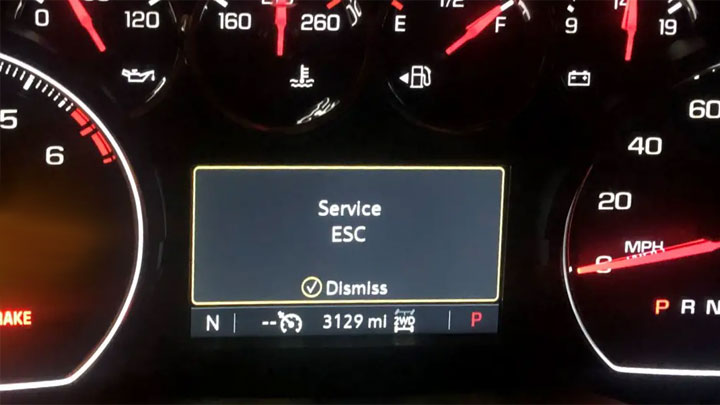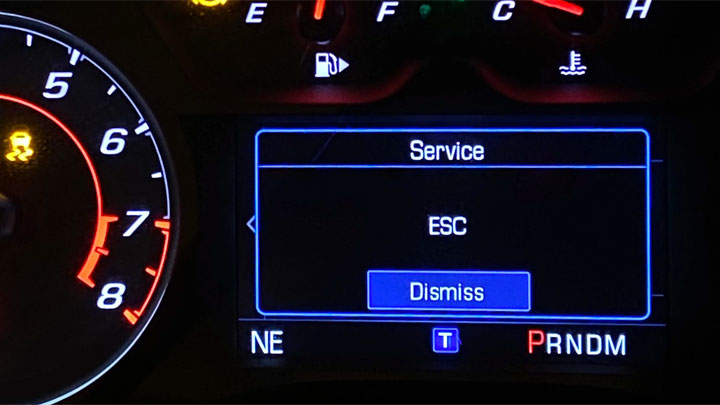Why Is My Electronic Stability Control (ESC) Light On?
“Your dash is lit up like a Christmas tree.” If you’ve had anyone say this to you, chances are you’ve passed up some much-needed maintenance on your vehicle. There’s also a good chance one of these lights belongs to your Electronic Stability Control system.
In this article, we’ll take a deep dive into all things ESC, DSC, ESP, and a many more acronyms you didn’t know you needed to know.

What Is Electronic Stability Control?
At a high level, Electronic Stability Control (ESC) is an automated system designed to keep your car going forward in the event you lose control. Whether it’s from snow, rain, mud, or sand—ESC tries its very best to keep those wheels pointed straight and the occupants of your vehicle safe. But what is it?
ESC is a system that starts the moment you turn on the car and works in the background while you drive along. It functions by keeping track of your steering inputs and the position of each of the wheels.
The moment you lose control, it will modulate throttle and brake inputs to hopefully keep your vehicle on the straight and narrow. This system is intended to keep you out of an accident.
Some manufacturers have specific names for their stability control systems like VSA in a Honda/Acura or AdvanceTrac in a Ford.

Examples of ESC In Action
I’ll give a few examples. If ESC senses your car is losing control to one side or another, it will apply brake pressure to the side it wants your car to go. Now this isn’t the robots taking over, it’s really just a way to keep your car going in a straight line—while keeping you on the surface with the most traction possible.
Now, how does ESC know which direction you want to go? This is actually pretty simple.
Remember when I mentioned the ESC is paying attention to your steering inputs? It interprets these inputs as your “commanded direction” and will try to maintain the most-recent direction in the event you lose traction. It’s assuming a lot here, so make sure you disable ESC and all other traction aids if you’re going to be doing any burnouts or drifting.
Another example of ESC implementation is if you lose traction and instead of applying pressure to the brakes, the ESC system instead cuts power to the transmission by limiting throttle inputs to the engine.
If you reduce speed, you have less of a chance of impacting another vehicle or object at dangerous speeds. It’s also handy if you don’t want to veer off the side of the road and flip your car over.
Stability Control vs Traction Control

The difference between stability control is like the difference between a glider you made in your basement and a modern fighter jet. Both fly, but they’re two different animals.
Traction control was developed first, so it’s a bit more simple but not as simple as ABS (Anti-Lock Braking System). It modulates throttle inputs and your car’s ABS to make sure your car doesn’t lose control so much that you won’t be able to recover and continue moving down the road safely.
Alternately, your Stability Control system leverages all of the tools your Traction Control system and ABS use—with the addition of a few more sensors.
A steering wheel and accelerator pedal sensor are added, along with a yaw sensor and a three-axis accelerometer. These sensors work in concert to inform an even more powerful computer of the vehicle’s intended path.
Interestingly enough, all vehicles produced since 2012 in the USA have mandatory stability control and almost all new vehicles today contain the holy trinity of driver safety aids—Stability Control, Traction Control, and Anti-lock braking system.
See Also: 6 Reasons Your Traction Control Light Is On
Why Is My ESC Light Flashing?
Your ESC light will flash when it senses you’ve lost control of your car. It’s pretty likely you’ll see this light flash when you start doing donuts in the snow, but if it’s flashing when you’re driving—try to pay attention to getting the car on the straight and narrow first.
If you’re at a standstill and the light is flashing for some reason, make sure you take your car to a certified mechanic.
Why Is My ESC Light On All the Time?
If your ESC light is on all the time, then you most-likely have a code being thrown by your car’s ECU. The solution for this issue is to plug in a code reader (here are some good options) to your OBD 2 port to scan for any engine codes (or drive to your local auto parts store to have them do it for you).
Then, go to the Google machine and search up that code—there could be a pretty simple fix you can do yourself. If the solutions seem like something that’s way over your head, make sure you take your car to your local mechanic.
Related: Why is My ABS Light On?
What Does “Service ESC” Mean?

This could mean a lot of things. As already mentioned, the first is that your engine is throwing a code that you can read using a scan tool.
Get the code read or head over to your local auto parts store and have them read that code. Then use Google to figure out what it means. Then, if it’s not something you can fix yourself, take your car to a mechanic.
What Can Cause Electronic Stability Control to Malfunction?
#1 – Faulty Wheel Speed Sensor
A bad wheel speed sensor (aka: ABS sensor) is typically the most common cause of the ESC light coming on (and staying on). Since the electronic stability control system relies so much on various sensors that monitor the car’s movement and direction, it’s a good bet one of these speed sensors is to blame.
#2 – Another Sensor Related to Stability Control
You could have an issue with another sensor related to your stability control system. For instance, the steering angle sensor is a necessary component of your electronic stability control system.
If the steering angle sensor fails, your car’s ESC system won’t be able to compare the data from your brakes and wheels to the direction you are aiming the car. To confirm, take your car to the mechanic.
#3 – Low Brake Fluid
While uncommon, it’s possible for the ESC system to be disengaged if the brake fluid level in your master cylinder gets to a low enough level.
Is It Safe to Drive With the ESC Light On?
Objectively, no. It is measurably LESS safe to drive with an ESC light on because that indicates that the ESC and other devices pertaining to your car’s traction are not working. This means you are more likely to lose control and not be able to recover the vehicle which can cause a more severe accident.
If you drive carefully, you should be OK, but it’s a good idea to that you take your car to the mechanic as soon as possible if you see your ESC light on.
Is There Any Reason to Turn Off Stability Control?

If you’re trying to drive your sports car around the track as fast as you can, turn off traction control. This way, you can feel everything a little bit better and the car won’t think you are losing control and try to cut power when you want to go faster around a corner.
Also, if you’re trying to do some drifting in snow, sand, or at a drift event on tarmac—you’ll want to turn off traction control as well. This way, you’ll be able to create maximum slip at the rear wheels and put power wherever you want.
All in all, you’ll turn off stability control when you want to have a bit of fun. 😉
- How to Reduce Wind Noise in Your Car (Locate the Source) - Nov 22, 2023
- How Long Can You Drive on a Spare Tire? (and How Fast Can You Go?) - Sep 13, 2023
- Why Is My Electronic Stability Control (ESC) Light On? - Apr 3, 2023
